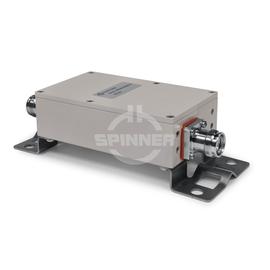SPINNER Filters offer reliability, performance, and value
Radio Frequency (RF) filters are crucial components in mobile communication and broadcast networks. Their primary function is to selectively allow signals of certain frequencies to pass while blocking others, thereby managing interference and enhancing the clarity and quality of the transmission. Applications include cellular base stations, broadcasting, and other RF communication systems.
Critical Characteristics and Success Factors:
- Selectivity: The ability to precisely isolate specific frequency bands.
- Insertion Loss: Minimal loss of signal strength through the filter.
- Power Handling: Capability to manage the power level of the signal without degradation.
- Durability: Performance consistency over a range of environmental conditions.
The Band-pass filter 3710-3800 MHz 10 W 4.3-10 female guarantees excellent, lossless mobile communication quality for use in in-building distributed antenna systems (DAS) or on mobile communication base stations outdoors.
Band-pass filters are critical in systems that need to isolate and transmit a defined range of frequencies, such as in specific communication channels in mobile networks or distinct broadcast frequencies.
The protection class is IP 67.
It supports the use of the following frequency bands : 3800
The 4.3-10 connector system was designed to meet the latest requirements in mobile communication in terms of size, robustness, performance, and other parameters. Its small footprint supports the use of smaller components, mitigates risks if equipment is assembled without due care, and delivers outstanding electrical performance.
Our RF filters are engineered with precision, offering exceptional selectivity and low insertion loss, which are critical for efficient RF communication. Our range includes filters designed for various specific applications, ensuring that whatever your needs, we have a filter that fits. With robust construction, our filters maintain performance across a broad range of environmental conditions, making them ideal for both mobile communication and broadcast networks.
Our unique approach to RF filter design combines innovative technology with practical application insights, resulting in products that not only meet but exceed industry standards. For anyone involved in the construction or operations of RF mobile communication or broadcast networks, our filters offer reliability, performance, and value.




